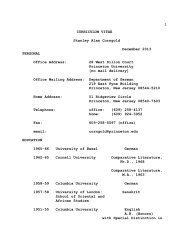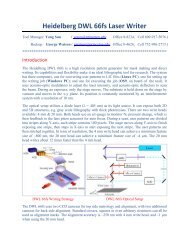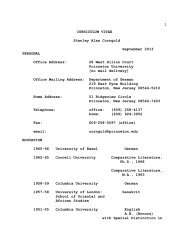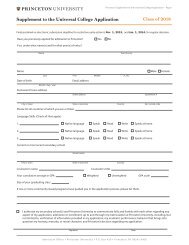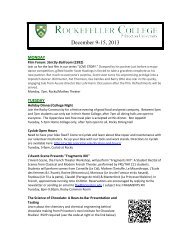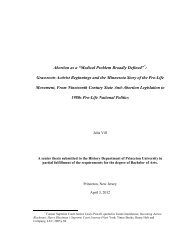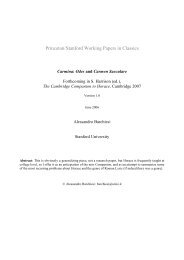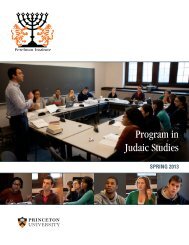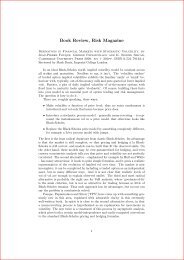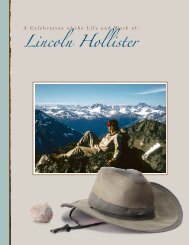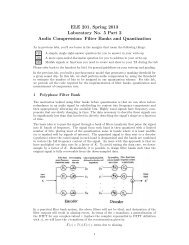Campaign residen the P -litics - Princeton University
Campaign residen the P -litics - Princeton University
Campaign residen the P -litics - Princeton University
Create successful ePaper yourself
Turn your PDF publications into a flip-book with our unique Google optimized e-Paper software.
of <strong>the</strong> visual arts program at <strong>the</strong> Lewis<br />
Center. He declined to give details<br />
about who was behind <strong>the</strong> duck, but<br />
acknowledged it was <strong>the</strong> culmination<br />
of a student’s project for his advanced<br />
sculpture course. “Art is all about persuasion,”<br />
Scanlan said, and <strong>the</strong> project<br />
“worked well as an artwork and as a<br />
kind of social experiment on <strong>the</strong> allure<br />
of privileged access and society.”<br />
The student behind <strong>the</strong> project,<br />
Diana Li ’13, attended <strong>the</strong> event, but<br />
denied any involvement. A few days<br />
later, though, she set <strong>the</strong> record straight.<br />
The ducks were “an arbitrary choice,” Li<br />
said, but <strong>the</strong> goal was “pushing boundaries<br />
and eliciting reactions — having<br />
people wonder how much trust can<br />
you put into this game, and reconsider<br />
what <strong>the</strong>y feel qualifies as art.”<br />
For Li, <strong>the</strong> most rewarding part of<br />
<strong>the</strong> project was being able to see <strong>the</strong><br />
responses from <strong>the</strong> audience — some<br />
of <strong>the</strong>m unpredictable. Even after Scanlan’s<br />
revelation about <strong>the</strong> art project, a<br />
group of students remained on <strong>the</strong><br />
floor, waiting for something to happen.<br />
Said Sarah Schwartz ’15: “I came here<br />
hoping for an explosion.” π<br />
ing Harvard and Rutgers, offer chaplaincies<br />
that support humanist, a<strong>the</strong>ist,<br />
agnostic, and o<strong>the</strong>r nonreligious campus<br />
communities.<br />
One of PUSH’s primary functions is<br />
to provide a welcoming community for<br />
students questioning religion, said Jackson,<br />
<strong>the</strong> group’s p<strong>residen</strong>t.<br />
“<strong>Princeton</strong> is a pretty open environment,”<br />
said Michael Pretko ’13. “No one<br />
would put you down for your religious<br />
beliefs or lack of religious beliefs.”<br />
Still, some students feel a stigma<br />
attached to a<strong>the</strong>ism, not just on campus<br />
— where <strong>the</strong>y say it is sometimes<br />
expressed with “a weird look” — but<br />
especially in <strong>the</strong>ir hometowns. Some<br />
describe <strong>the</strong>mselves as “closet a<strong>the</strong>ists.”<br />
“People want to talk about <strong>the</strong>ir<br />
background, <strong>the</strong>ir history, how <strong>the</strong>ir<br />
beliefs are changing, and whe<strong>the</strong>r <strong>the</strong>ir<br />
families are accepting of <strong>the</strong>m,” Schiff<br />
said. “You want to make sense of an ethical<br />
system and talk with o<strong>the</strong>r people,<br />
without having to invoke religion —<br />
and feel safe and comfortable.” π<br />
From<br />
<strong>Princeton</strong>’s<br />
vault<br />
Aframefit<br />
for a king<br />
What: A 2010 restoration<br />
regilded a picture frame that<br />
<strong>Princeton</strong> <strong>University</strong> Art Museum<br />
curator Karl Kusserow calls<br />
“among <strong>the</strong> most storied in<br />
American art.”<br />
As every tourist learns at<br />
Nassau Hall, <strong>the</strong> 252-year-old<br />
frame (shown here in original<br />
condition and during restoration)<br />
contained a portrait of King<br />
George II until his image was<br />
decapitated by a cannonball in<br />
<strong>the</strong> Battle of <strong>Princeton</strong>. Ano<strong>the</strong>r<br />
portrait was inserted: that of<br />
George Washington (below).<br />
The monarch was revered for<br />
giving <strong>the</strong> college its charter, but amid Revolutionary tumult a gilded crown<br />
was hacked off <strong>the</strong> top of <strong>the</strong> frame. No one knows exactly when.<br />
Where: <strong>Princeton</strong> <strong>University</strong> Art Museum<br />
By W. Barksdale Maynard ’88<br />
In <strong>the</strong> 1777 battle, a fusillade of cannonballs<br />
drove British stragglers out of<br />
Nassau Hall, ruining <strong>the</strong> portrait in <strong>the</strong><br />
process. The trustees commissioned<br />
Charles Willson Peale to paint “Washington<br />
at <strong>the</strong> Battle of <strong>Princeton</strong>” at just<br />
<strong>the</strong> right size to fit <strong>the</strong> handsome frame.<br />
Twice rescued when <strong>the</strong> building caught<br />
fire, Peale’s portrait continued to grace<br />
Nassau Hall until it was removed in<br />
2005, with its frame, to <strong>the</strong> art museum<br />
for safekeeping. A replica picture hangs<br />
in <strong>the</strong> Faculty Room today.<br />
Restoration has added palm leaves atop<br />
<strong>the</strong> famous frame – but no crown.<br />
paw.princeton.edu • May 16, 2012 <strong>Princeton</strong> Alumni Weekly<br />
PHOTOS: ELIZABETH HARKINS BAUGHAN; JEFFREY EVANS/PRINCETON UNIVERSITY ART MUSEUM<br />
P<br />
29




